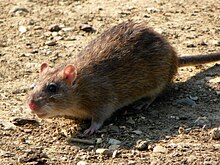Sewer rat
| Brown rat | |
|---|---|
 |
|
| Brown rat | |
| Scientific classification | |
| Kingdom: | Animalia |
| Phylum: | Chordata |
| Class: | Mammalia |
| Order: | Rodentia |
| Family: | Muridae |
| Genus: | Rattus |
| Species: | R. norvegicus |
| Binomial name | |
|
Rattus norvegicus (Berkenhout, 1769) |
|
 |
|
| Brown rat range | |
The brown rat (Rattus norvegicus), also known as the common rat, street rat, sewer rat, Hanover rat, Norway rat, Norwegian rat, or wharf rat, is one of the best known and most common rats.
One of the largest muroids, it is a brown or grey rodent with a head and body length of up to 28 cm (11 in) long, and a slightly shorter tail. It weighs between 140 and 500 g (4.9 and 17.6 oz). Thought to have originated in northern China, this rodent has now spread to all continents except Antarctica, and is the dominant rat in Europe and much of North America, making it by at least this particular definition the most successful mammal on the planet alongside humans. With rare exceptions, the brown rat lives wherever humans live, particularly in urban areas.
Selective breeding of Rattus norvegicus has produced the laboratory rat, a model organism in biological research, as well as pet rats.
Originally called the "Hanover rat" by people wishing to link problems in 18th century England with the House of Hanover, it is not known for certain why the brown rat is named Rattus norvegicus (Norwegian rat), as it did not originate from Norway. However, the English naturalist John Berkenhout, author of the 1769 book Outlines of the Natural History of Great Britain, is most likely responsible for popularizing the misnomer. Berkenhout gave the brown rat the binomial name Rattus norvegicus, believing it had migrated to England from Norwegian ships in 1728.
By the early to middle part of the 19th century, British academics believed that the brown rat was not native to Norway, hypothesizing (incorrectly) that it may have come from Ireland, Gibraltar or across the English Channel with William the Conqueror. As early as 1850, however, a new hypothesis of the rat's origins was beginning to develop. The British novelist Charles Dickens acknowledged this in his weekly journal, All the Year Round, writing:
...
Wikipedia

